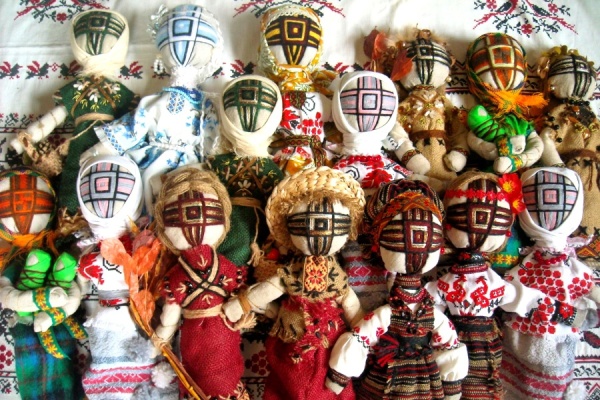 What is a doll, what is the history of its origin, what is it for - if we delve into the essence of this phenomenon, we can find information that can be useful. So, Wikipedia gives us a definition of a doll as some kind of object made in the form of a person, sometimes an animal. A doll is made from a wide variety of materials: wood, plastic, fabric, paper, porcelain and many other materials. The word "doll" itself has different meanings, direct and figurative, and in the figurative sense it means - a very fashionably dressed woman, stupid at the same time and soulless. This is how linguist Dahl defines this phenomenon in the "Explanatory Dictionary of the Living Great Russian Language".
What is a doll, what is the history of its origin, what is it for - if we delve into the essence of this phenomenon, we can find information that can be useful. So, Wikipedia gives us a definition of a doll as some kind of object made in the form of a person, sometimes an animal. A doll is made from a wide variety of materials: wood, plastic, fabric, paper, porcelain and many other materials. The word "doll" itself has different meanings, direct and figurative, and in the figurative sense it means - a very fashionably dressed woman, stupid at the same time and soulless. This is how linguist Dahl defines this phenomenon in the "Explanatory Dictionary of the Living Great Russian Language".
On the information resources of specialists - master puppeteers, for example, you can find the definition of a doll as a reduced model of a person or animal, sometimes fictional, and what is characteristic - a doll at different times in its history had different purposes. Since the 20th century, dolls have become not only a subject of play, but also an element of collection. Although the game function has been preserved for them even today.
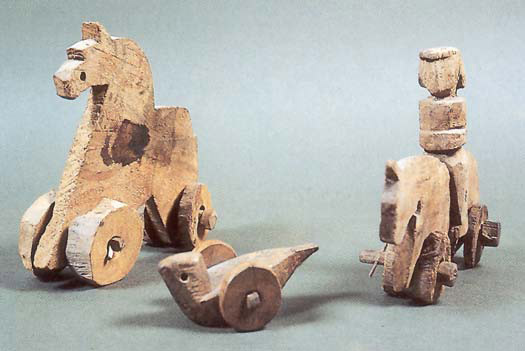 Traditionally, we are used to imagining a doll as a favorite toy, a part of our childhood, remembering doll shops and the atmosphere of a fairy tale and acting that was hidden behind their doors. But this concept is much deeper and broader if we think about a folk, Slavic doll. And then a completely different world will open before us, even a whole gallery of worlds - and they will contain philosophy, religion, magic, psychology and many other flows of information and energy. Traditions, rites, rituals, history, culture - all this is carried by a folk doll.
Traditionally, we are used to imagining a doll as a favorite toy, a part of our childhood, remembering doll shops and the atmosphere of a fairy tale and acting that was hidden behind their doors. But this concept is much deeper and broader if we think about a folk, Slavic doll. And then a completely different world will open before us, even a whole gallery of worlds - and they will contain philosophy, religion, magic, psychology and many other flows of information and energy. Traditions, rites, rituals, history, culture - all this is carried by a folk doll.
We are probably all familiar with creepy voodoo dolls, other equally scary creatures and objects used in magic. They personify a person in various magical rituals and witchcraft, being methods of sympathetic magic - magic, which assumes that all actions performed with a doll, after magical accompaniment, will also occur with the person himself, who is the object of witchcraft. This is inherent in different cultures, for example, European, African, Native American.
 But first of all, as we are used to seeing, a doll is more of a toy, a souvenir, a character. If it is skillfully made, an author's - it can rightfully be considered a work of art, it will be awaited in collections, moreover - in museums. A doll is also present in various fields of human activity, such as, for example, a mannequin doll. And each type of doll has its own formed history, interesting, and sometimes useful.
But first of all, as we are used to seeing, a doll is more of a toy, a souvenir, a character. If it is skillfully made, an author's - it can rightfully be considered a work of art, it will be awaited in collections, moreover - in museums. A doll is also present in various fields of human activity, such as, for example, a mannequin doll. And each type of doll has its own formed history, interesting, and sometimes useful.
The history of dolls with sacred meaning is especially interesting - it has its roots in ancient times, surrounded by pagan idols, hidden behind symbols, intertwined with religion, associated with sculpture, depicted in various materials - wood, clay, stone. Its prototypes were Gods and Goddesses, spirits, good and evil. Such dolls participated in rituals and ceremonies, replaced a person in various religious actions, worked as amulets for our ancestors. It is quite likely that at the same time, play dolls appeared, which calmed the child, inspired his imagination and developed the necessary social skills. The history of the doll is very closely connected with the history of man as a whole, which means that it has no less years, and perhaps all 40-50 thousand years, if historians are to be believed.
The first doll, the fact of the existence of which was first recorded by scientists, is considered to be a doll made of mammoth bone, which was found in the Czech Republic during excavations, and is about 30-35 thousand years old. It had movable limbs, completely preserved. Dolls were still in the most ancient civilizations - Rome, Egypt, Greece - this is evidenced by archaeological excavations. The material from which they were created is clay, stone, wood, ivory. Dolls made of wood were found in Egyptian tombs as early as 2000 BC. Dolls from Egypt, with movable arms - legs and even a set of clothes, were found in 200 BC. In the first century AD, clay dolls were made in Greece. In the third century BC, rag dolls were in Rome. Dolls were found alongside little Egyptians in tombs during excavations, and they were dressed in fashionable clothes of the time.
 And traditional Japanese dolls - their history cannot fail to arouse interest. Among them you can see Dogu dolls, dating back to 8000-200 BC, Haniwa funeral dolls, 300-600 BC. In the 11th century, archaeologists found dolls that served as toys.
And traditional Japanese dolls - their history cannot fail to arouse interest. Among them you can see Dogu dolls, dating back to 8000-200 BC, Haniwa funeral dolls, 300-600 BC. In the 11th century, archaeologists found dolls that served as toys.
As for the Slavic motanka doll, its history dates back to the Trypillya culture. These settlements of people in the territory that is now called Ukraine existed even before the formation of Kievan Rus, and it was from here that the ancestors of the Slavs began their settlement to the north, northeast, that is, the territory that is now part of modern Russia. This settlement deep into the Great Forest took place along river arteries, so the tribes escaped by fleeing from the raids of nomads, leaving their rich black soil lands of the Great Steppe.
The Trypillya settlements originated in 5400 BC. The civilization itself lived for about two thousand years, until 3200 BC. Traces of this civilization were first discovered in 1897 near Kyiv, near the village of "Trypillya", from where the name came from. The archaeologist who discovered this life is Vikenty Khvoyka.

The similarity of the Trypillian culture and the culture of the islands located in the Aegean Sea indicates that the territory of Trypillian was inhabited by tribes who came from the Mediterranean, and thus a single space of ethnic groups was created between the shores of Crete and the Dnieper.
It was the Trypillians who were among the first to start growing crops instead of gathering plants, and to start breeding domestic animals instead of hunting. This was facilitated by natural conditions favorable for the beginning of agriculture and cattle breeding.
I would like to cite excerpts from the works of Alexander Strazhny "Archetypes of the ancient tribes of the Dnieper region. Trypillya civilization". So, he says that the civilization of Trypillya was the first among the agricultural societies of that time to solve the issue of food security. And so seriously that the products were used not only by themselves, but also exported to other civilizations that existed in those days - Egypt, Mesopotamia, the Caucasus, Asia Minor, Crete, the Balkans.
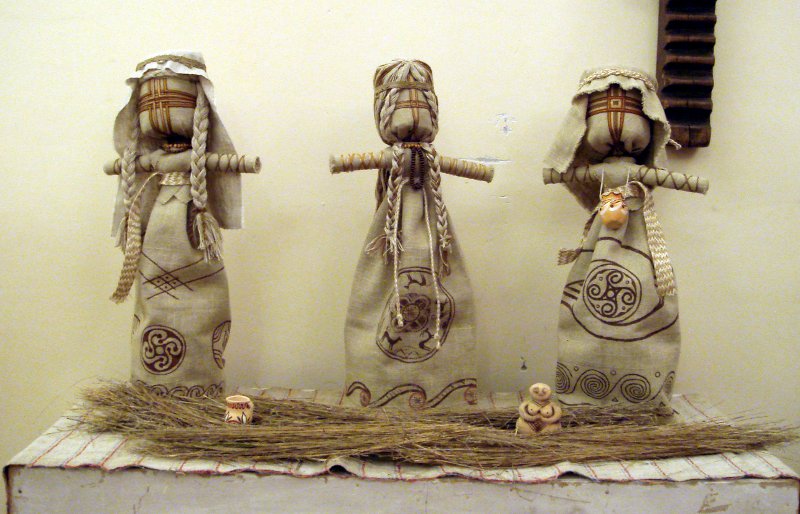 High agricultural abilities coexisted with the talents of craft workshops. The use of stone tools was characteristic of that time, and in Trypillia already in 3600-3150 BC. silicon was processed in workshops as the main Neolithic raw material. It was used for arrowheads, scrapers, sickles, axes and other useful household items.
High agricultural abilities coexisted with the talents of craft workshops. The use of stone tools was characteristic of that time, and in Trypillia already in 3600-3150 BC. silicon was processed in workshops as the main Neolithic raw material. It was used for arrowheads, scrapers, sickles, axes and other useful household items.
Bronze began to be used and processed in the world at the end of the 3rd millennium BC. And Trypillian bronze objects are recorded in the 5th millennium, and of high quality - without gas porosity or shrinkage defects or cracks. And there were a lot of these objects in use, so copper tools were not a luxury or unique products.
Judging by all the excavations and finds, we can be sure - the Trypillian society lived a peaceful, prosperous life, almost heavenly. And it is not difficult to live in paradise if there are no enemies. And there are no traces and signs of serious military battles or clashes - only signs of small conflicts, for example, several dozen arrowheads were found in one place. And that's all! The tribes of the wild steppes did not exert pressure on the settlements of Trypillian, which is not surprising - after all, they did not exist then. There was a domesticated horse, but the harness tells us that it was not used for military purposes.
 The sacred beliefs of the Trypillians were very similar to the worldview of the ancient peoples who lived in later centuries, including the Slavs. The cult of the Great Mother, the sun and its image in the form of a spiral, cross, circle, the bull as a symbol of wealth and agriculture, symbols of heaven, water. The forces of nature also deserved worship - Heaven, Sun, Earth, Water. The idea of a world system in three tiers, the possibility of rebirth of the human soul through magical rituals. Altars in the form of crosses, bowls for subsequent sacrifices, temples of various cults were created, which were quite complex architectural structures.
The sacred beliefs of the Trypillians were very similar to the worldview of the ancient peoples who lived in later centuries, including the Slavs. The cult of the Great Mother, the sun and its image in the form of a spiral, cross, circle, the bull as a symbol of wealth and agriculture, symbols of heaven, water. The forces of nature also deserved worship - Heaven, Sun, Earth, Water. The idea of a world system in three tiers, the possibility of rebirth of the human soul through magical rituals. Altars in the form of crosses, bowls for subsequent sacrifices, temples of various cults were created, which were quite complex architectural structures.
A special place was occupied by the figure of a woman in the culture of Trypillya. She was treated with respect, as evidenced by numerous female images, statues, and figurines. In each settlement, archaeologists found clay figures of Gods. The statue of the Mother Goddess was a symbol of fertility and motherhood, and was often depicted as the goddess Makosh, known to the Slavs, holding her hands raised up.
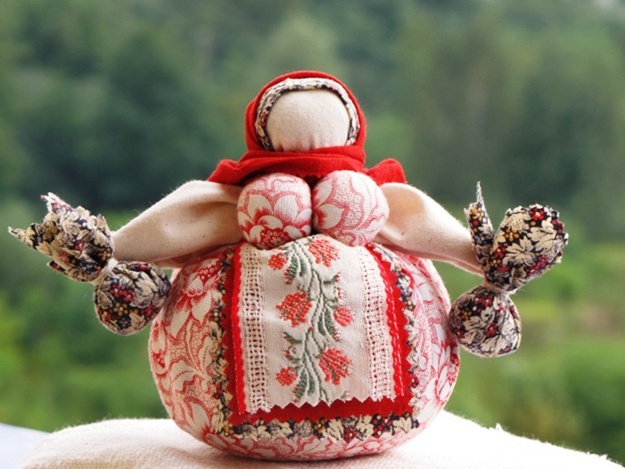 Society at that time highly respected women. Images and figurines of women were endowed with special beauty and reverence, were highly artistic, full of primitive eroticism and very aesthetic. Women were serious craftsmen and respected housewives, ran the household and were engaged in arts and crafts, for example, painting ceramics. Weaving, making and decorating clothes, decorating them with ornaments - these are the places where women's hands and creative power were applied. Archaeologists often found looms in houses. Scientists are sure that the decorations on utensils and household items, on clothes were a reflection of primary magic, contributed to negotiations and interaction with otherworldly forces, and could protect and defend the owner of the house and its inhabitants.
Society at that time highly respected women. Images and figurines of women were endowed with special beauty and reverence, were highly artistic, full of primitive eroticism and very aesthetic. Women were serious craftsmen and respected housewives, ran the household and were engaged in arts and crafts, for example, painting ceramics. Weaving, making and decorating clothes, decorating them with ornaments - these are the places where women's hands and creative power were applied. Archaeologists often found looms in houses. Scientists are sure that the decorations on utensils and household items, on clothes were a reflection of primary magic, contributed to negotiations and interaction with otherworldly forces, and could protect and defend the owner of the house and its inhabitants.
It is quite possible that the motanka dolls originated even then, in the era of the developed civilization of Trypillya, being an element of female magic, which is somewhat reminiscent of meditation - calming and tuning in to a wave of high power. The motanka doll was passed down from ancestors to descendants, personifying the Knowledge that goes from generation to generation, Knowledge. in which traditions, values, beliefs and views are intertwined.
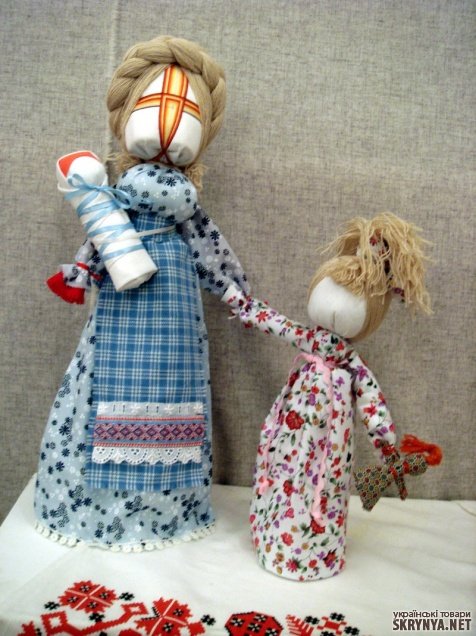
The creation of the doll begins with its winding, and this happens in a spiral, which is very similar to the spiral twisting of energy vortices. This also indicates growth, development, causes associations with the emergence, birth of something new, its multiplication. The entire Universe moves in a spiral, and this is the most natural direction. The spiral reminds us of the creation of the whole world, is related to the words "whirlpool", "swaddler", "midwife" and other similar Russian and Ukrainian words of the same root. The fact that the doll is faceless is also sacred - this shows its presence outside the boundaries of time and space, makes it similar to the Great Goddess, and gives it the function of a conductor of power. The facelessness of the doll supports the process of energy exchange with the owner, so it can always serve as a talisman. If the face-image is created more clearly, even imposed on perception, it may not be a reflection of the inner world of the person for whom it was created as a talisman, and then the task of the doll will be violated and it will be impossible to protect the person, and after all, for this purpose it was created. The Trypillya spiral, which arises at the moment of twisting-forming the doll's head, conveys the idea of the doll's purpose, of the goals and tasks that caused its creation. The creator of the doll winds those thought images that arise in his head and are directed at the person to be protected, into the doll's head, spiritualizing it with this pure energy of his intention. When the head-twist is covered with a piece of cloth, the doll comes to life and is taken to fulfill its protective task.
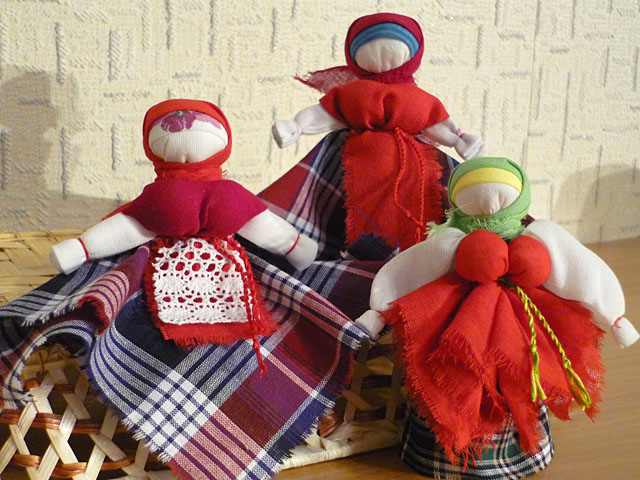 One of the historians-researchers, Lyudmila Tymoshenko, believes that the motanka doll is a continuation of the messages passed down to us from our ancestors, encrypted in clay monuments, in burials, and household items. All this was marked by archaeological research. In Trypillya settlements, archaeologists discovered toy dishes, which means that the doll must have existed at that time. Weaving, patterns on fabric, and ornaments on ceramics serve as evidence of the version that the roots and origins of the motanka are still there, in Trypillya culture, because its worldview is so deeply sacred and filled with creativity.
One of the historians-researchers, Lyudmila Tymoshenko, believes that the motanka doll is a continuation of the messages passed down to us from our ancestors, encrypted in clay monuments, in burials, and household items. All this was marked by archaeological research. In Trypillya settlements, archaeologists discovered toy dishes, which means that the doll must have existed at that time. Weaving, patterns on fabric, and ornaments on ceramics serve as evidence of the version that the roots and origins of the motanka are still there, in Trypillya culture, because its worldview is so deeply sacred and filled with creativity.
The knowledge and rules of creating dolls were carefully guarded, even the name of the dollmaker who created the motanka was hidden from strangers, because she was the guardian of the rituals and cultural traditions of the family, she alone possessed this feminine magic perfectly. This is how what came to the ancestors from their ancestors was protected as an important and valuable heritage.
The reasons for the disappearance of the Trypillian civilization have not been studied and exist only in conjectures and versions. Perhaps its existence was due to natural factors, and the disappearance is directly related to one of the catastrophes or natural cataclysms. The territory of Eurasia, for example, depended on the phases of cooling and warming, and this was really quite a vital urgent issue. Climate researchers speak of these periods as climatic mini-apocalypses.
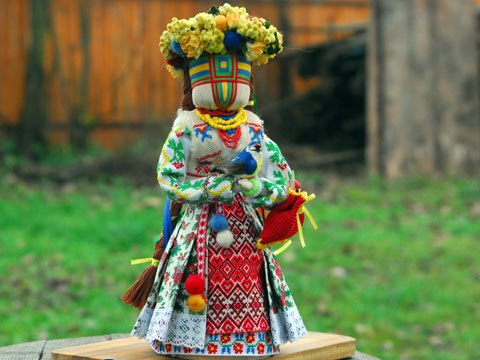 Let's return to Alexander Strazhny and his archetypes. He says in his work that from the second half of the 3rd millennium BC, where the cities of Trypillia were yesterday, settlements of some tribes of the "pit" culture were formed. These tribes were a kind of mixture of semi-nomadic communities, very aggressive, and such an alliance lasted for about a thousand years. "Pit people" lived in settlements of small villages, consisting of pits-dugouts, or from fortified settlements for defense against possible attacks. For the next thousand years, the entire Bronze Age, tribes with different cultures lived in the lands of modern Ukraine. Researchers have found about twenty cultures: catacomb culture, cord pottery, log culture and others. All these tribes lived their own lives, developed in different ways and had different levels of development, had their own cults, beliefs and gods, and yet they had much in common, which is evidence of a certain continuity of values inherent in this territory.
Let's return to Alexander Strazhny and his archetypes. He says in his work that from the second half of the 3rd millennium BC, where the cities of Trypillia were yesterday, settlements of some tribes of the "pit" culture were formed. These tribes were a kind of mixture of semi-nomadic communities, very aggressive, and such an alliance lasted for about a thousand years. "Pit people" lived in settlements of small villages, consisting of pits-dugouts, or from fortified settlements for defense against possible attacks. For the next thousand years, the entire Bronze Age, tribes with different cultures lived in the lands of modern Ukraine. Researchers have found about twenty cultures: catacomb culture, cord pottery, log culture and others. All these tribes lived their own lives, developed in different ways and had different levels of development, had their own cults, beliefs and gods, and yet they had much in common, which is evidence of a certain continuity of values inherent in this territory.
There are historians who believe that the ancestors of the Slavs, a union of peoples of related origin, with common lands and similar languages, also arose at the same time.
As Oleksandr Strazhny writes, Trypillya, like all other highly developed civilizations, ceased to exist at the moment when History so commanded. But all the products of entire generations of the Bronze Age - "catacomb dwellers", "pit dwellers", "log frame dwellers", etc. - bear the symbols of Trypillya. They are also clearly visible on the ceramics of the Iron Age, the so-called Scythian-Greek period, they are borne by gray vases of the Chernyakhiv culture. Agricultural technologies, ornament, harvest rituals, etc. continued in Kievan Rus.
 It is a pity, but the cloth doll could not have survived from the time of Trypillya to the present day. Therefore, the history of its origin in this civilization is an unproven version, no matter how weighty guesses it is accompanied by. In addition, during the Soviet Union, it was not customary to speak out loud about the very fact of the existence of this civilization, so as not to provoke Ukrainians into kinship with such a highly developed ancestor. The position is a bit strange, since the Slavs as a whole have a direct relationship to this ancestor and can rightfully be proud of it.
It is a pity, but the cloth doll could not have survived from the time of Trypillya to the present day. Therefore, the history of its origin in this civilization is an unproven version, no matter how weighty guesses it is accompanied by. In addition, during the Soviet Union, it was not customary to speak out loud about the very fact of the existence of this civilization, so as not to provoke Ukrainians into kinship with such a highly developed ancestor. The position is a bit strange, since the Slavs as a whole have a direct relationship to this ancestor and can rightfully be proud of it.
Historians are still not sure and are not unanimous in the question of the history of the origin of the Eastern Slavs. This question has not been fully studied and has different versions, in particular about the territories of its formation and the time of this process. The most common and convincing version claims that the first stage of the development of Slavism, otherwise called Proto-Slavic, takes place in the second half of the 2nd - 1st millennium BC. Historians consider this period to be the beginning of the formation of archaeological cultures, which later became characteristic of the Slavic peoples.
The life and way of life of the Slavs have always been very closely intertwined with nature and its mystical forces, as well as with family relationships, so the cult of veneration of the forces of nature arose, as well as the cult of ancestors. The objects of worship were the Forces of Nature: the Sun, the Earth, the Moon, the Sky. The beliefs of the Slavs became paganism, the most revered gods in the pantheon were the Gods of Heaven and Earth, the God of Fire, the God of Thunder and Lightning, the God of the Sun, the Goddess of Will and other forces. In addition to the higher deities, there were also smaller spirits, both good and evil - foresters, housewives, mermaids, bathers, spirits of diseases and many others, associated with the processes and life of their ancestors. At this time, there was already a calendar for twelve months, for four seasons. The day of the vernal equinox served as the beginning of the calendar year, when the day became longer than the night and dominated it.
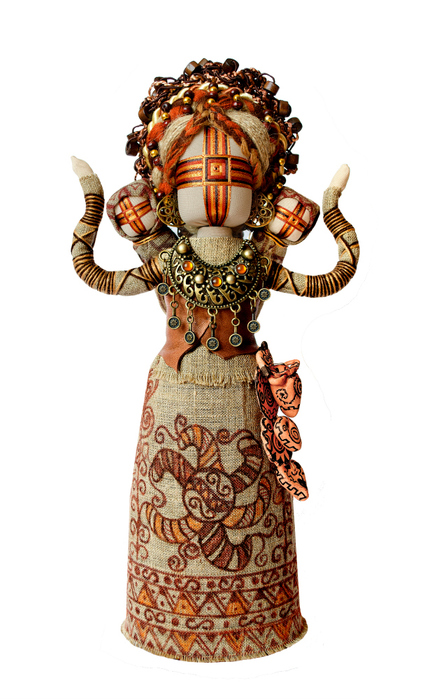 Boris Akunin, in his book "History of the Russian State," when addressing the question of the origin of the Slavs, mentioned that Slavic roots and movements on the map are very vague and not proven.
Boris Akunin, in his book "History of the Russian State," when addressing the question of the origin of the Slavs, mentioned that Slavic roots and movements on the map are very vague and not proven.
Thus, the author writes, around the second century of the Christian faith, tribes begin to be mentioned that can be called Slavic, as written sources say. And already in the middle of the first millennium, the Slavs began to divide into groups - western, central, eastern, and each in turn perceived the cultural influence of its closest geographical neighbors, thus acquiring new ethnic shades and losing some of the previously existing ones.
The East Slavic tribes were united into a single state - Kievan Rus, but before that, according to most historians, the ancestors of the Ukrainians - the Drevlyans, Polyans, Severians, Tiverts, Volynians, also known as Dulibs, White Croats - lived on this territory; the ancestors of the Russians - the Krivichi, Slovenes, Vyatichi, Radimichi; and the ancestors of the Belarusians - the Polovtsy, Dregovichi. The Slavs settled and inhabited new lands, and this process was finally completed, according to historians, at the beginning of the 8th century. Territorially fixed unions of tribes, large and small, with their own cultural and everyday characteristics were formed. When the place of residence was assigned to each group of Slavs, the tribes began to lose their former names and replaced them with new ones, in connection with this, the division of tribes, which was mentioned above, by ancestors is conditional. The formation of a new state with Kyiv at its center took place in several stages during the 8th-9th centuries.
It is characteristic that the sacred motanka doll has the same meaning among all Slavs. The technologies for creating the doll are also similar, taking into account, of course, the regions, with their traditions, rules and peculiarities that arose under the influence of differences in cultural, climatic features, geopolitical and historical processes and events throughout the territory of residence of the ancient Slavs.
 Dolls in the North were twisted from birch bark, in the South - from straw, sometimes from corn cobs. Different conditions, as we see, dictate different materials in the manufacture of motanka.
Dolls in the North were twisted from birch bark, in the South - from straw, sometimes from corn cobs. Different conditions, as we see, dictate different materials in the manufacture of motanka.
Ukrainian motanka dolls have more clearly defined heads, sometimes due to the absence of arms and legs. Even in the territory of the present-day North Caucasus, archaeologists have found motanka dolls. These dolls also have a cross-shaped face, like Ukrainian ones, but the shape of the cross in the Dnieper region, for example, is a solar cross, and Caucasian dolls bear a sign on their faces that is more similar to Trypillian symbols, in particular fertility and the feminine principle. The cross on the face is also characteristic of dolls from some Russian regions, the Kursk and Belgorod regions, for example, Chuvashia, Khakassia. Researchers suggest that such a cross-shaped face came from Asia, because there, in the regions of Kyrgyzstan, Uzbekistan, Tajikistan, these symbols adorn the faces of dolls. Historians suggest that this can be explained by the influence of Scythian culture on the economy, culture, and social structure of these lands in the 6th-4th centuries BC. And Scythia carries within itself the achievements and features of the civilizations of Greece, the East, and Rome.
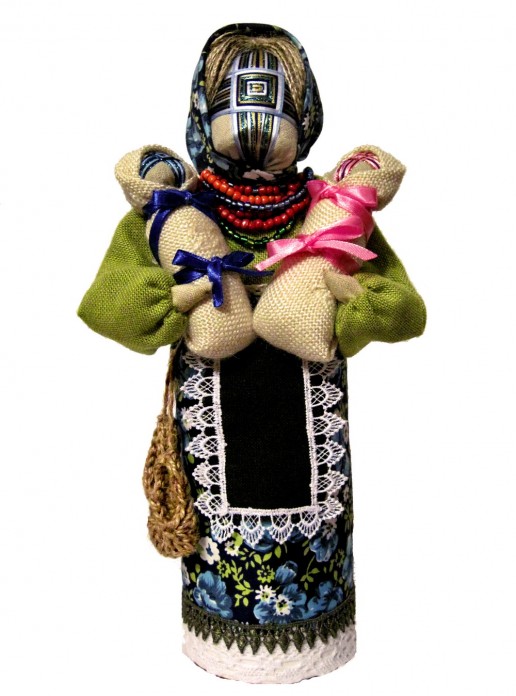 The work "Russian Cloth Doll" states that the cross-shaped faces of cloth dolls are woven in a complex pattern of multi-colored threads, and this process was inherent in different ethnic cultures, it was among the Ossetians, Georgians, Kyrgyz, and Uzbeks. In the regions of southern Russia, traditional Motan dolls had their faces drawn with red thread in the shape of an oblique cross. As the craftsmen of the Kursk and Belgorod regions explained, this meant the doll's chin and chubby cheeks.
The work "Russian Cloth Doll" states that the cross-shaped faces of cloth dolls are woven in a complex pattern of multi-colored threads, and this process was inherent in different ethnic cultures, it was among the Ossetians, Georgians, Kyrgyz, and Uzbeks. In the regions of southern Russia, traditional Motan dolls had their faces drawn with red thread in the shape of an oblique cross. As the craftsmen of the Kursk and Belgorod regions explained, this meant the doll's chin and chubby cheeks.
Researchers see a connection between cross-shaped embroidery on doll faces and astral signs, symbols, and the deity of the Sun. The symbol of the oblique cross is a sign of incantation, a sign of fertility; traditionally, it is drawn across the doll's chest; South Russian cloth dolls wear it on their faces, where it is inscribed in a symbolic solar circle. Such dolls had no hair, and this is indicative - the head, large, larger than real proportions, with no hair, in the shape of a ball, itself personified the sun. Sometimes even the main outfit of such a doll was not made in order to emphasize the symbol, as, for example, the ash doll of Voronezh. This ideal form, the shape of a circle, was a symbol of stability, security, and the repetition of life, which was inherent in the solar cross.
The popularity of motanka dolls was very high, particularly in villages and districts, throughout Ukraine, Russia, and Belarus, almost until the middle of the last century.
There are traditions of doll making to this day, even if the meaning of a particular feature is not always remembered, but the craftsmen carefully carry them in their work and pass them on to their students. Yes, much of the cultural heritage of our ancestors has, unfortunately, been irretrievably lost, but much is being revived.

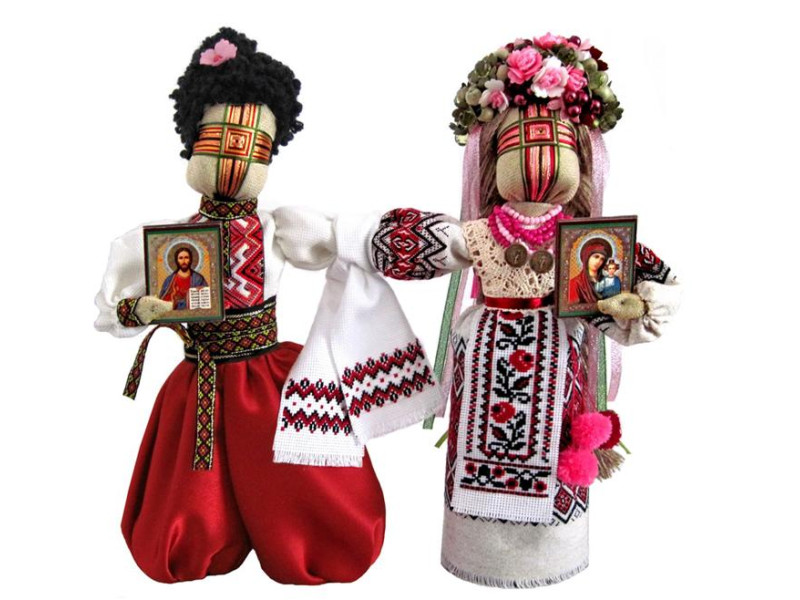
Write a comment